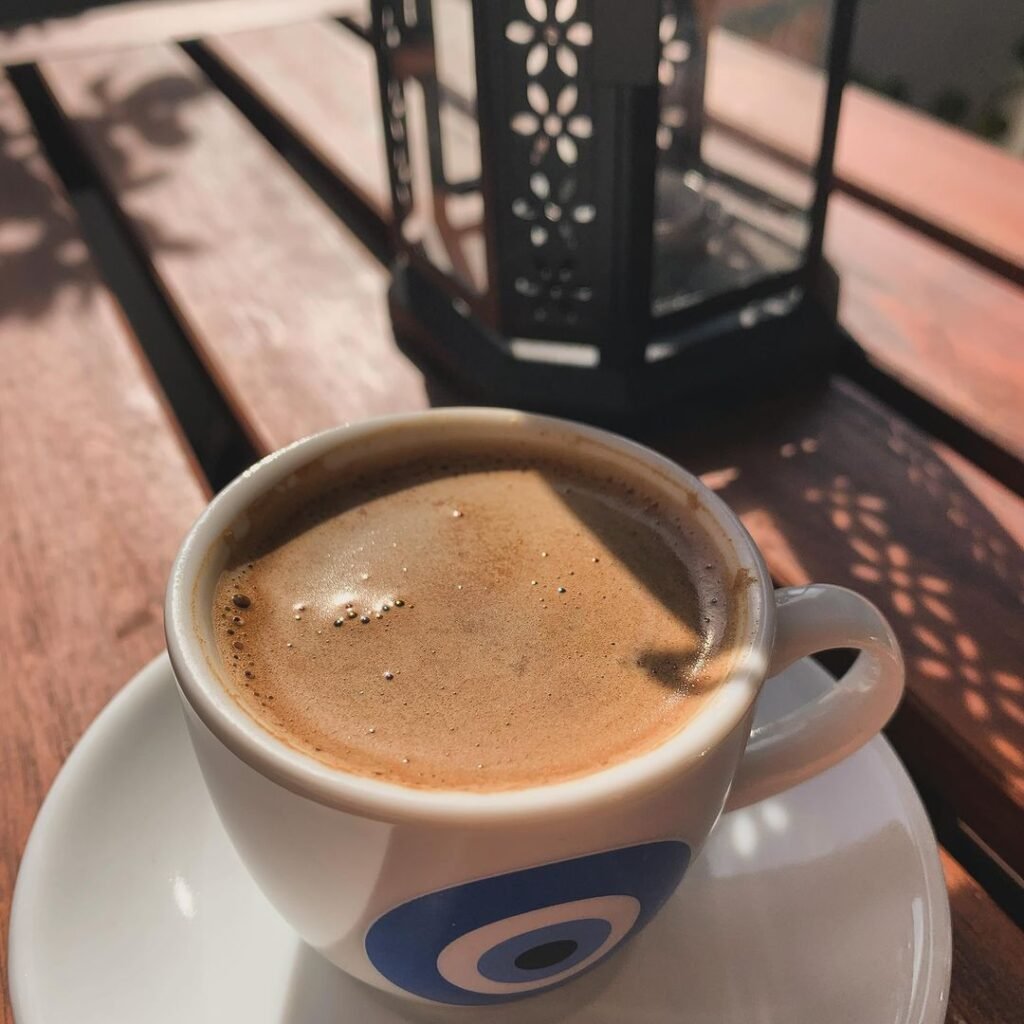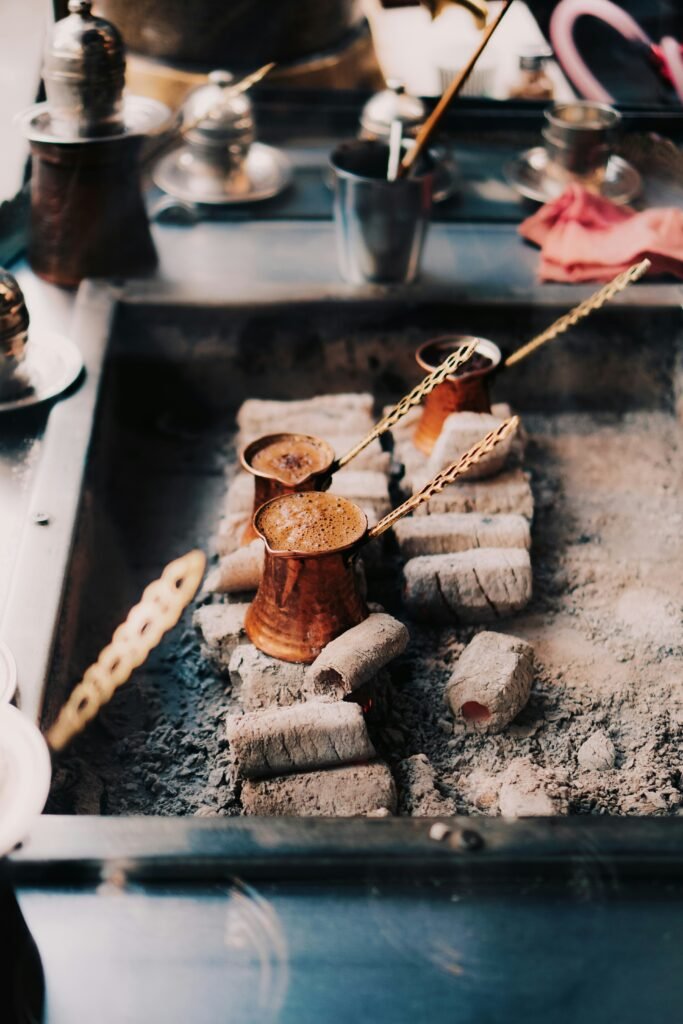Have you ever found yourself sitting in a quaint café on the sun-drenched Greek island of Crete, sipping a rich, velvety coffee and wondering about its origins? If so, you’re not alone. The debate over whether the beloved “Greek coffee” is actually Greek or Turkish has been brewing for centuries. Let’s dive into this fascinating cultural conundrum that’s as complex and layered as the coffee itself.

A Coffee by Any Other Name
First things first: what exactly is Greek coffee? Known for its strong flavor and unique preparation method, this coffee is finely ground and brewed unfiltered in a small pot called a briki. The result is a thick, potent brew served in a small cup, often accompanied by a glass of cold water.
But here’s where things get interesting. If you travel to Turkey, you’ll find an almost identical coffee called “Turkish coffee.” In Armenia, it’s “Armenian coffee,” and in Cyprus, “Cypriot coffee.” So, what’s the story behind these seemingly interchangeable names?

A Journey Through Time and Taste
To understand the controversy, we need to take a little trip back in time. Coffee first made its way to the region during the Ottoman Empire’s reign in the 16th century. The Ottomans, who controlled much of southeastern Europe, western Asia, and northern Africa, introduced coffee to the lands they conquered, including Greece.
For centuries, this style of coffee was known throughout the region as “Turkish coffee,” a nod to its Ottoman origins. However, as nations gained independence and sought to establish their own identities, the name of the coffee became a point of contention.
The Greek Renaming: More Than Just a Cup of Joe

In Greece, the shift from “Turkish coffee” to “Greek coffee” gained momentum in the 1960s and 1970s. This change wasn’t just about coffee – it was deeply rooted in the complex political relationship between Greece and Turkey.
Remember the Cyprus crisis of 1974? It was around this time that many Greeks began to distance themselves from anything associated with Turkey, including the name of their beloved coffee. The renaming was a way for Greeks to assert their national identity and distance themselves from their historical oppressors.
Not Just a Greek Thing
Interestingly, this phenomenon isn’t unique to Greece. Many countries in the region have their own names for essentially the same type of coffee. In Bosnia and Herzegovina, it’s “Bosnian coffee,” in North Macedonia, “Macedonian coffee,” and so on. Each country has adapted the coffee to its own tastes and traditions, claiming it as part of their cultural heritage.

The Art of Preparation: A Universal Ritual
Despite the naming disputes, the method of preparing this coffee remains remarkably similar across cultures. Whether you’re in Athens, Istanbul, or Yerevan, you’ll likely see it made the same way:
- Finely ground coffee is mixed with cold water in a briki.
- The briki is heated slowly, allowing a foam (called “kaimaki”) to form on top.
- Just as it’s about to boil over, it’s removed from heat.
- This process may be repeated to create more “kaimaki”.
- The coffee is served in small cups, with the grounds settling at the bottom.

A note on “kaimaki”:
A crucial element in this preparation process is the formation of the kaimaki, the coveted foam that crowns a perfectly brewed cup of Greek coffee. This golden-brown froth is more than just a visual treat; it’s a testament to the brewer’s skill and the coffee’s quality. A rich, thick kaimaki indicates that the coffee has been brewed correctly, with the right temperature and timing.
Coffee connoisseurs often judge the quality of their brew by the presence and consistency of this foam. In fact, in Greece, it’s not uncommon to hear people say, “I don’t want coffee, I want kaimaki!” – emphasizing just how important this frothy layer is to the overall experience. The kaimaki not only enhances the coffee’s flavor but also helps to seal in its heat, allowing you to savor your brew at just the right temperature.

A Taste of Crete
Speaking of preparation, if you’ve ever visited the beautiful island of Crete, you’ve likely experienced the local coffee culture firsthand. In the charming cafes of Chania or the bustling markets of Heraklion, you’ll find locals and tourists alike savoring their cups of “Greek coffee.”
Cretans have a particular fondness for this brew, often enjoying it as part of their daily routine. It’s not uncommon to see groups of friends or family members gathered around a table at a Greek taverna or at a traditional “kafeneio”, sipping their coffee and engaging in lively conversation – a scene that epitomizes the warm, social nature of Cretan culture.

More Than Just a Beverage
In Greece, as in many other countries in the region, this style of coffee isn’t just a drink – it’s a social ritual. It’s meant to be sipped slowly, savored, and enjoyed in the company of others. This coffee is rarely taken to-go; instead, it’s an excuse to sit down, relax, and connect with friends or family.
There’s even a tradition of fortune-telling associated with the coffee grounds left in the cup. Known as tasseography, this practice involves interpreting the patterns formed by the grounds to predict the drinker’s future. Whether you believe in it or not, it’s a fun and intriguing aspect of the coffee culture.
The Health Debate: Another Brewing Controversy

As if the naming debate wasn’t enough, there’s also ongoing discussion about the health implications of this strong brew. Some studies suggest that the unfiltered nature of the coffee may raise cholesterol levels. However, other research points to potential benefits, such as improved heart health and lower diabetes risk.
One thing’s for sure: with its high caffeine content, this coffee packs a punch. It’s not uncommon for drinkers to feel a significant energy boost after just one small cup.
A Matter of Taste
At the end of the day, whether you call it Greek coffee, Turkish coffee, or something else entirely, what matters most is the experience it provides. The rich aroma, the velvety texture, the ritual of preparation and consumption – these are the elements that have made this style of coffee beloved across cultures and generations.
For many of us who have fallen in love with Greece and especially the island of Crete, this coffee is an integral part of the experience. It’s a taste of the laid-back Mediterranean lifestyle, a reminder of sun-soaked holidays and warm hospitality.

Embracing the Controversy
So, is it Greek or Turkish? The answer, like the coffee itself, is complex and multi-layered. While its origins may be Ottoman, the coffee has become an important part of Greek culture and identity. Perhaps instead of focusing on ownership, we can appreciate how this humble beverage has transcended borders and become a shared cultural touchstone across the region.
Next time you’re in Crete, whether you’re exploring the Old Town of Chania or lounging on a Cretan beach, take a moment to order a cup of Greek coffee. As you sip it slowly, savoring its rich flavor and velvety texture, remember the centuries of history and culture in your cup. And who knows? You might just start your own love affair with this contentious yet delightful brew.
After all, in a world that often seems divided, isn’t there something beautiful about a cup of coffee that can bring people together, regardless of what name it goes by?
